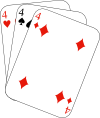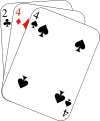Overview
This is definitely more my cup of tea, and the reason this site was formed. I have searched for hand and foot canasta rules online and have yet to find a main set of rules, similar to what you find for classic canasta. I have also never found the set of rules that was taught to me. For these reason, I have decided to present in this section the rules I am most familiar with, and also present some of the variations I have found online.
The basic objective of Classic Canasta, making melds and canastas, is the same in Hand and Foot Canasta. The main differences between the two are:
- Hand and Foot players are given two hands, also called a hand and a foot; Classic players are given only one
- One red or dirty canasta and two black or clean canastas are required to go out in Hand and Foot; one canasta of any type is required in Classic
- Hand and Foot uses five decks of cards; Classic uses two
The rules given in the following pages are for four players, but there is no variation in the rules if your are playing with less or more players. This will be discussed more in the Number of Player Variations page.
The Cards
For this game you will need five standard decks of cards including Jokers. That's 270 cards total, if you feel like counting them all. Each card is assigned a point value. The values of the cards are used for two purposes, determining how many cards are necessary to meet the minimum initial meld value and in scoring a hand after some one has gone out. Both of these topics will be discussed later in the Game Play and Going Out/Scoring sections. Listed below are the point values of each card.
| Card(s) | Point Value |
|---|---|
| 4-7 | 5 |
| 8-K | 10 |
| A, 2 | 20 |
| Jokers | 50 |
| 3 | See Special Cards |
Special Cards
There are several cards that have a special purpose in Canasta. These cards are wild cards (Jokers and twos) and threes.
Wild cards can be used in place of any natural card in a meld, provided that there are more natural cards than wild cards. Therefore, it is not possible, and illegal, to make a meld of wild cards.
Red and black 3's serve little purpose in this game. They can't be melded and only count as negative points if a player is left with them in their hand at the end of the game. Red 3's are worth -300 points and black 3's are worth -100 points. Therefore it is usually a good idea to discard these cards as soon as possible.
Game Play
Determining Partners
When I usually play Hand and Foot Canasta, we just sit down at the table, and the person you are sitting across from becomes your partner. I think this is probably the simplest method, but if you are interested in another method see the Determining Partners section of Classic Canasta.
The Hand and Foot
After a player receives the two stacks of cards, they choose, without looking at the cards, which stack of cards they would like to play first. This is considered a player's hand, with the other stack of cards being called the foot. After a player gets rid of all the cards in their hand, they move on to their foot. A player can't go out until they get rid of their foot. However, a player's partner may go out if their partner is not in their foot. This is not usually a good idea since players do not know what cards their foot contains, and they could be stuck with a lot of negative points. Having two hands makes scoring at the end interesting, because if a player is not in their foot yet all of those cards count against that player and their partnership.
Basic Turn
The basic turn consists of drawing cards, making melds, and discarding cards. The first player to go is usually the score keeper and rotates to the left. With four players, each person gets to start one hand, since there are four rounds. A player's turn starts by drawing two cards from either or both stocks or taking the discard pile, subject to certain restrictions (see Taking the Discard Pile). Melds can be made or added to, at the player's discretion provided that they have already met the initial meld requirements. This is discussed more on the Melds page. At the end of every turn a player must discard one card but also keep at least one card in their hand if they are not able to go out (see Going Out).
Mends and Canastas
Melds


A meld consists of at least 3 cards of the same rank (i.e. three 3's), and must include more natural cards than wild cards. The first meld laid down by either partner must meet a minimum requirement for the number of points it contains. The number of points melds are worth is determined by adding up the point values of all of the cards to be laid down in the initial meld. Any number of melds can be counted towards the minimum, but bonuses for canastas don't count. The minimum count for the initial meld depends on which round the game is on as shown in the table below.
| Round | Minimum Count |
|---|---|
| 1 | 60 |
| 2 | 90 |
| 3 | 120 |
| 4 | 150 |
After either partner makes the initial meld, melds may be made without worrying about the count of the card being laid down.
Canastas
When a meld contains 7 cards it is then considered a canasta. Although natural cards can still be added to canastas, the cards making up a canasta are usually stacked and put to the side to indicate they are a canasta. Usually the top card of the stack is used to indicate whether a canasta is natural (clean) or mixed (dirty). A red card indicates a canasta that doesn't contain wild cards, or a natural canasta. A black card indicates a canasta that contains wild cards, or a mixed canasta. This really isn't necessary but it makes counting up the canasta bonuses at the end of the round easier. Red canastas are usually more desirable because they have a higher bonus, but because you need 7 cards of one value they are often harder to get. As mentioned above, natural cards can be added to completed canastas but not wild cards.
Discard Pile
In Canasta it is possible to pick up the discard pile, and it is often advantageous to do so since the more cards you have in your hand, the more options for making canastas and melds there will be. The only way that you can pick up the discard pile is if a player has a natural card in their hand. A player is only allowed to take the discard pile at the beginning of their turn. To take the discard pile, the player must show the pair that matches the top card and meld those cards immediately. The player then takes the next 4 cards in the discard pile, for a total of 5 cards.
When a player discards a wild card, the discard becomes frozen and remains frozen for the rest of the round. Unlike Classic Canasta, this is the only way the discard pile is frozen.
Going Out/Scoring
Going Out
A player goes out when they discard or meld the last card in their hand. This isn't as simple as it sounds though. A player is not allowed to go out unless they have completed 2 black or dirty canastas and 1 red or clean canasta. Although not required, it is usually a good idea for a player to ask their partner before they go out in case the partner has a lot of high point value cards in their hand that will count against that partnerships score. However, the partner's response can only be a yes, no or I wouldn't advise it.
Scoring
This is probably the most difficult and lengthy part of the game. Scoring can be done in any order the score keeper wishes. Given below, is the order I usually use when determining the score for a hand. Scoring consists of two parts: bonuses and the point values of the cards. Bonuses are a fixed amount of points awarded for canastas, red threes and going out. The bonuses awarded for each situation are given below:
| Bonus Type | Points Awarded |
|---|---|
| Natural Canasta | 500 each |
| Mixed Canasta | 300 each |
| Going Out | 100 |
In the above table it is important to note that the going out bonus is only scored once per partnership, but the other bonuses are scored for each player and added into a single score for the partnership. The different bonuses a partnership earned are added up and added to the score sheet.
After the bonuses are recorded, the point values of the cards left in a player's hand and/or foot are added up and recorded as a negative number on the score sheet for each partnership. For example, if two 4's are left in a player's hand and their partner has a 5 and K left, a -25 (5+5+10+5) would be recorded on the score sheet. This is where the 3's come into play. For each red 3 a player has in their hand, -300 points are added to the total negative score. For each black 3 a player has in their hand, -100 points are added to the total negative score. Next, the point values of the cards on the table are added up. This includes the cards in melds and completed canastas. This value is recorded as a positive value on the score sheet. If a player only has a few cards in their hand it is possible to remove cards with the same point value from the table. This basically automatically subtracts negative point from the final car point value total. For example, if a player has 25 points left in their hand, they can remove 25 points worth of cards from the table instead of subtraction points on the score sheet. Each player counts the point value of their cards and then the two players in a partnership add their individual scores together.
The total score for a partnership for the round is the total of the above mentioned values. Unlike Classic Canasta, the score for each round has no bearing on the game. It is only the total score after all 4 rounds that is important. Like most other games, the partnership with the highest score wins.
Number of Player Variations
Besides playing with four players, Hand and Foot Canasta can also be played with two, three, or six players. The rules for any number of players are the same as when you are playing with four players. The only difference is when you are playing with two or three players there are no partnerships, each player plays for themselves. Hand and Foot Canasta is not normally played with five people, but if you wanted to it would be similar to playing with three people where each person plays for themselves.
External Links/Sources
Used on this Site
No external site were used in writing the Hand and Foot Rules given on this site. They are the rules that I was taught and usually play by.
Other Sites with Classic Canasta rules
- Pagat.com
- More to Come